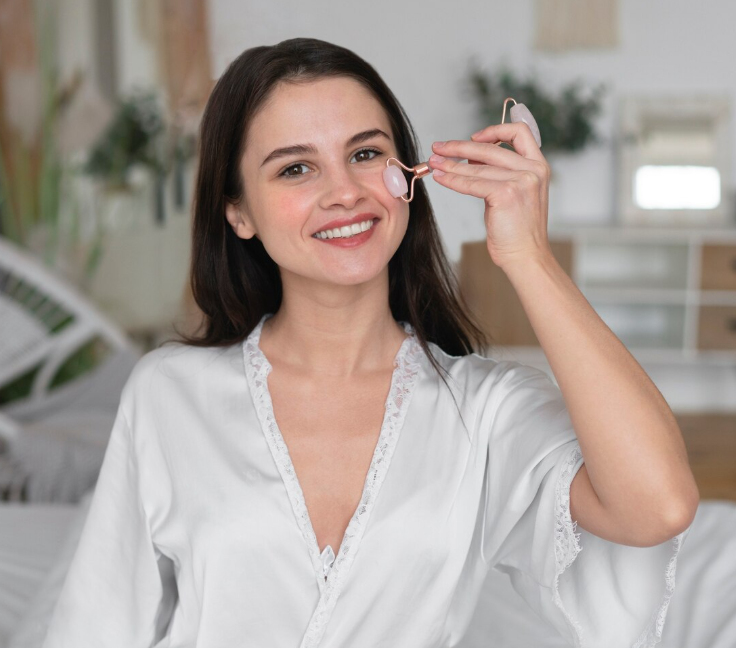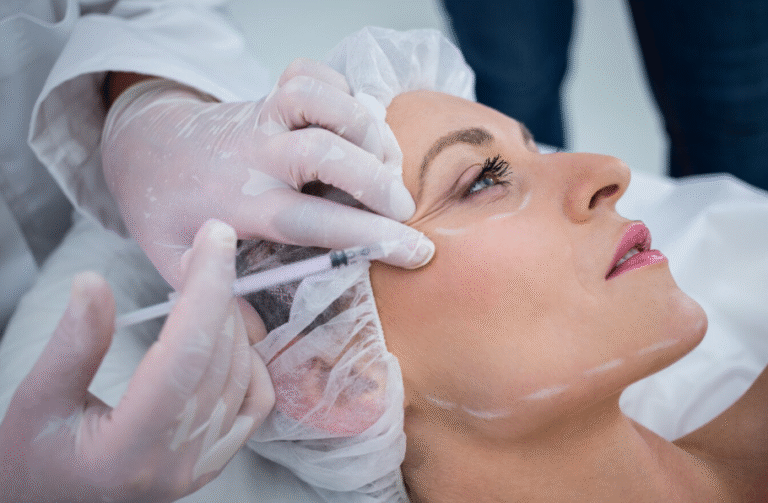Treatment Overview
Triple Combination Creams (TCC) are prescription-strength topical treatments commonly used in Korea to manage melasma, sun spots, post-inflammatory hyperpigmentation (PIH), and uneven skin tone.
These creams combine three key active ingredients:
- Hydroquinone (HQ): A skin-lightening agent that inhibits melanin production.
- Tretinoin (Retinoid): Stimulates cell turnover and disperses melanin.
- Corticosteroid: Reduces inflammation and irritation caused by the other actives.
This synergy makes TCC one of the most effective topical therapies for hyperpigmentation. Korean dermatologists often prescribe triple combination creams alongside laser toning, chemical peels, or oral medications (tranexamic acid) for optimal pigment control.
Purpose & Benefits
- Melanin Suppression: Hydroquinone blocks melanin formation.
- Exfoliation & Renewal: Tretinoin speeds cell turnover, fading dark patches.
- Anti-Inflammatory Effect: Steroid reduces irritation and stabilizes melasma activity.
- Melasma Management: Especially effective for epidermal and mixed-type melasma.
- Supports Other Treatments: Enhances outcomes of lasers and peels.
- Dermatologist-Supervised: Safe and effective when used in Korea under medical guidance.
Ideal Candidates
Triple Combination Creams in Korea for hyperpigmentation are recommended for:
- Patients with melasma, especially epidermal or mixed-type.
- Individuals with post-acne pigmentation or sun spots.
- Adults who want a non-procedural, at-home treatment.
- Those needing maintenance after in-clinic pigmentation therapies.
Comparison with Other Treatments:
- Triple Combination Creams: Best for long-term topical control of melasma.
- Pico Laser / BB Laser: Best for deeper pigmentation and resistant melasma.
- Chemical Peels: Best for surface pigmentation.
- Cosmelan / Dermamelan: Stronger peel systems for recurrent hyperpigmentation.
- Tranexamic Acid Injections: Best for resistant melasma combined with vascular factors.
Possible Risks & Complications
While effective, triple combination creams require medical supervision due to potential side effects:
- Redness & Irritation: Common during initial use.
- Peeling & Dryness: Due to tretinoin.
- Steroid-Related Risks (long-term use): Thinning of skin if overused.
- Rebound Pigmentation: If discontinued abruptly.
💡 Korean dermatologists typically recommend short-term use (8–12 weeks) followed by maintenance with milder brightening creams or oral supplements.
Treatment Techniques Used
- Application Protocol: Applied at night to pigmented areas, avoiding sensitive zones.
- Cycle Duration: Typically used for 2–3 months, with follow-up dermatologist review.
- Maintenance Strategy: Transition to milder brightening agents (arbutin, vitamin C, azelaic acid) after initial pigment clearance.
- Combination Therapy: Often prescribed alongside lasers, peels, or oral tranexamic acid.
Recovery & Aftercare
- First 1–2 Weeks: Possible peeling, dryness, and redness.
- 4–6 Weeks: Visible lightening of pigmentation.
- 2–3 Months: Significant reduction in melasma and dark spots.
Aftercare Tips:
- Apply soothing moisturizer daily.
- Use SPF 50+ sunscreen religiously, as sun exposure reverses progress.
- Avoid harsh exfoliants or overlapping active ingredients.
- Follow dermatologist’s instructions carefully—do not self-prescribe.
Results & Longevity
- Short-Term (4–6 Weeks): Noticeable pigment lightening.
- Medium-Term (8–12 Weeks): Major improvement in melasma and hyperpigmentation.
- Long-Term: Maintenance with milder agents or repeat cycles under medical supervision.
Treatment Process in Korea
- Consultation & Skin Analysis – Doctor confirms pigmentation type and suitability for TCC.
- Prescription & Education – Cream provided with detailed usage instructions.
- Treatment Phase – Applied nightly for 2–3 months.
- Monitoring – Regular dermatologist visits to adjust strength or frequency.
- Maintenance – Transition to safer, non-steroid brightening solutions.
- Combination Care – May be paired with Pico laser, peels, or Vitamin C infusion.
Why Korea is a Top Destination
- Korean dermatologists are experts in melasma management, tailoring TCC use carefully.
- Clinics often integrate TCC into multi-step pigmentation programs.
- Safer short-cycle regimens prevent long-term steroid misuse.
- Affordable consultations and prescription access compared to Western countries.
- Seoul is known for cutting-edge pigment protocols combining topical and in-clinic care.
Cost Range (Detailed Breakdown)
Pricing for Triple Combination Creams in Korea for hyperpigmentation:
- Prescription Cream (1–2 months supply): USD 30 – 80
- Dermatology Consultation: USD 20 – 50
- TCC + Laser Package: USD 500 – 900 (3–5 sessions + prescription cream)
- Premium Pigmentation Program (TCC + Pico Laser + Infusion Therapy): USD 1,200 – 2,000
Additional Costs in Korea:
- Add-ons (Vitamin C infusion, PRP, Exosomes, Rejuran): USD 150 – 500
💡 Patients often describe Triple Combination Creams as the “first-line melasma fighter”, effective when used correctly under Korean dermatologists’ supervision.
Popular Clinics in Seoul
- Banobagi Dermatology – Prescription TCC + laser melasma care.
- Oracle Dermatology – TCC + Vitamin infusion maintenance protocols.
- Renewme Skin Clinic – Triple combination therapy with PRP/skin boosters.
- View Plastic & Dermatology – TCC integrated with Pico laser packages.
- Chaum Anti-Aging Center – Luxury melasma management with TCC + multi-step programs.




